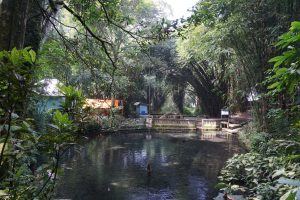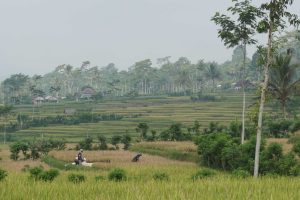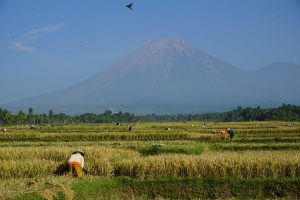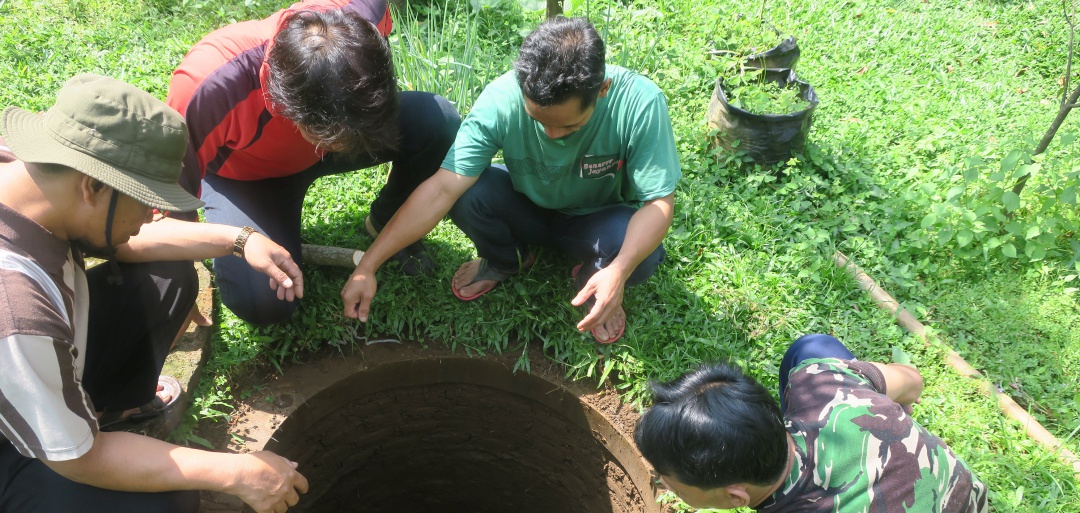After years of preserving the bamboo forest, villagers of Sumbermujur of East Java are bearing the fruit of their hard labor, as water continues to flow from the Deling spring, allowing them to continue farming, consume clean water even during the dry season. Read more.
By Ika Ningtyas
Lumajang, EAST JAVA. While other villages suffer from drought, Sumbermujur village of Lumajang district, East Java, continue to see its dwellers actively farming and consuming clean water from a water spring. The key, is preserving the bamboo forest.
Up until the 1990s, restoring the bamboo forest was never thought to be a need for Sumbermujur villagers who went on cutting down bamboos to build houses, make kitchen utensils, handicrafts, to selling bamboo roots for consumption. This common practice resulted in the significant decline of bamboo forest area, down to 30 percent, and slowing water discharge to only 300 liters per second.
“Back in the old days, all houses were made of bamboos. So, if [villagers] wanted to build a house or fence, they get [bamboos] from the bamboo forest,” said Kusman, head of Kali Jambe farmer group at the village.
In 2000, when they realized water discharge from the spring was declining, Kusman added, several villagers started to replant cleared areas with bamboo. They started with three hectares.
Joko Triono, one of the bamboo forest managers, said they had chosen to use bamboos to conserve the water spring, for their relatively easy care and maintenance.
“Bamboo maintenance is very easy and can be done by anyone. It grows fast too,” said Triono.
In 2005, the East Java administration issued a permit for an additional five hectares of forest area to be managed by Sumbermujur villagers, making a total of 14 hectares of bamboo forest, replanted.
The additional five hectares, about three kilometers from the village, is located in the slopes of Semeru Mountain of East Java.

The bamboo trees of several types including bambu apus (Gigantochloa apus), petung (Dendrocalamus asper), ori (Bambusa arundinacea) and rampal (Schizostachyum branchyladum) –, now stand between 18 to 20 meters tall, forming a natural forest canopy surrounding the water spring, giving the water spring its name Deling, which translates to bamboo in the local language.
Rudi Mulyono, one of forest bamboo caretakers said, the restoration of bamboo forest has increased water discharge of the spring up to 600 liters per second, more than enough to supply drinking water to 7,000 villagers and irrigate 436 hectares of farming area mostly for paddy rice field, crops, coffee, cabbage, and tomato during dry season.
During rainy season, water discharge can reach up to 1,000 liters per second.
Suharsih, 60, is one of the villagers who benefit from the increased water discharge.
“We never experience water scarcity anymore,” she said. Suharsih owns one hectare of farming land.
Following the increased water supply, Kusman, head of Kali Jambe farmers group said, rice productivity had increased from nine tons per hectare up to 12 tons per hectare during each harvest, higher than other villages’ production which produce up to eight tons per hectare.
“From one harvest, each family can earn Rp25 million (US$1,797),” he said recalling that farmers used to queue for three to seven days to get water and often got engaged in a scuffle with others over rationing.
Since 2012, pipes were installed to channel water from the spring to villagers’ houses. By 2018, pipes have reached nearly 1,900 households. There are currently 20 families that are not part of the pipe network as they are located on a much higher ground.
Villagers now have access to clean water by paying as low as Rp5,000 (US$ 0.36) per month.
“I don’t have to use the well anymore. [Water supply] for drinking, shower and washing come from Deling spring,” said Ngatiyam who used to spend Rp50,000 (US$3.49) per month for water.

Wigit Yulianto, an official from Sumbermujur village, said the water spring also irrigates neighboring villages, — Penanggal, Tambahrejo, and Kloposawit –, which are located more than 30 kilometers from his village.
“[They receive water] because their springs have dried up during dry season,” said Yulianto to Ekuatorial, adding that the village administration issued a regulation to preserve bamboo forest in 2007.
He cited the regulation stipulates for villagers to submit two to five bamboo seedlings as a wedding dowry to be planted at the forest. In addition, illegal logging of bamboo will be subjected to Rp50,000 (US$3.59) fine per bamboo stem.
“The fine is to establish a deterrent effect. However, for villagers who really need bamboos can inform local officials so that we’ll choose old bamboo to cut in order to avoid the penalty,” he said claiming that the regulation has been fully implemented by villagers.
“Ever since the regulation was issued, there have been no [reports of] illegal logging. Villagers opted to plant bamboos in their own backyard or fields for their own necessities,” said Yulianto.
Bamboo In Water Conservation
Indonesian bamboo taxonomy expert, Elizabeth Anita Widjaja, said preserving water springs by planting bamboo is the right step due to the plant’s ability to absorb water during rainy season and release water during dry season.
“In deforested areas, especially on top of hills that are prone to water scarcity, it’s best to plant bamboos to collect water,” said Widjaya, who is former senior researcher of Biology Research Center at the Indonesian Institute of Sciences, through an email.
Widjaya also said that bamboos are effective in preventing erosion, landslide, and floods, provided the types chosen are suitable with the area’s topography.
She cited small and low stem bamboos, also most common types, including the Bambusa vulgaris, Bambusa glaucescens and Bambusa jacobsii – are best and most effective for steep slopes.
“For steep slopes, avoid planting types [of bamboos] with large diameters and long such as giant bamboo (Dendrocalamus asper) to prevent them to collapse during heavy rains or landslides,” she said.
Using bamboos, she added, to conserve water springs and prevent landslides has been implemented by NGOs and private sectors in East Java mountains, including Willis, Penanggungan, Arjuno, and Welirang.
Unfortunately, Widjaja also note that the government is yet to optimize bamboos in water conservation and landslide prevention efforts and it remains difficult for local people to obtain permit to plant bamboos in protected forest areas.
“The government does not need to allocate money for seedlings, and planting is done by local people. However, obtaining permits can take up too much time and often difficult,” she said.
“In fact, by planting bamboos, [you will get] two main benefits: prevent erosion and conserve water springs. But, bamboos remained excluded and not considered instrumental [in conservation].”

Meanwhile, Wawan Hadi Siswanto from the Lumajang Regional Mitigation Disaster Agency, said that his administration is having difficulties to preserve water springs on villages prone to drought because of rejection from neighboring villages.
“We have offered to conserve water springs by [planting] bamboos at the villages [located on] higher grounds in Probolinggo with the condition that the water can irrigate our villages hit by drought,” said Siswanto. “However, local villagers have refused to allow water to be channeled to Lumajang [district] fearing that they will be left with no water. So, we have tried but we haven’t found the solution.”
The Lumajang administration has been trying to restore water catchment areas, located in the neighboring district, Probolinggo, by planting bamboos, to address water scarcity which hit at least 15 of their villages since early June.
However, due to rejection from Probolinggo villagers, Siswanto said, that the agency had distributed 120,000 liters of water to the 15 villages starting in early June and will continue to do so for the next five months.
“We have no other solutions. [Currently] what we can do is supply clean water,” he added.
Myth Helps Preserve Bamboo Forest
Apart from replanting, Sumbermujur villagers also turn to a local folklore to preserve their water spring; the sacred freshwater eel (Anguilla spp), or locally known as sidat fish.
Rudi Mulyono, one of the bamboo forest’s caretaker, said that local villagers believe that doom would fall upon those who hunt and consume these eels, that are considered as the sacred guardian of Deling water spring.
Mulyono recalled the myth began to circulate after a villager, against the warning from other villagers, hunted and consumed eels from Deling spring and was found dead the next morning. Following that incident, local villagers came to believe the myth of the sacred eel of Deling spring
Notwithstanding the myth, Mulyono underlined that eels have important role for the spring as the species is known as catadromous fish; they migrate to rivers to spawn.
“Sidat fish loves to swim in water springs. During its reproduction phase, sidat will migrate through rivers to go to oceans. That way, sidat fish can push through water veins,” he said adding that protection to sidat fish had already been included in the 2007 village regulation on preserving bamboo forest.
The regulation prohibits wildlife hunting, especially fishing by poison and electrocution. Ekuatorial.
